In Class 9 Mathematics, Chapter 2 introduces the concept of Polynomials, which are algebraic expressions consisting of variables, constants, and exponents combined using mathematical operations. This chapter lays a strong foundation for algebra by explaining different types of polynomials (such as linear, quadratic, and cubic), their degrees, and coefficients. Exercises 2.1 to 2.4 cover important topics such as identifying polynomials, adding and subtracting polynomials, and using algebraic identities.
Class 9 Math Ch 2 Polynomials Ex 2.1 to 2.4 – Textbook
Ex 2.1 Class 9 Maths
Question 1.
Which of the following expressions are polynomials in one variable and which are not? State reasons for your answer.
(i) 4x2 – 3x + 7
(ii) y2 + √2
(iii) 3 √t + t√2
(iv) y+ 2y
(v) x10+ y3+t50
Solution:
(i) We have 4x2 – 3x + 7 = 4x2 – 3x + 7x0
It is a polynomial in one variable i.e., x
because each exponent of x is a whole number.
(ii) We have y2 + √2 = y2 + √2y0
It is a polynomial in one variable i.e., y
because each exponent of y is a whole number.
(iii) We have 3 √t + t√2 = 3 √t1/2 + √2.t
It is not a polynomial, because one of the exponents of t is 12,
which is not a whole number.
(iv) We have y + y+2y = y + 2.y-1
It is not a polynomial, because one of the exponents of y is -1,
which is not a whole number.
(v) We have x10+ y3 + t50
Here, exponent of every variable is a whole number, but x10 + y3 + t50 is a polynomial in x, y and t, i.e., in three variables.
So, it is not a polynomial in one variable.
Ex 2.1 Class 9 Maths Question 2.
Write the coefficients of x2 in each of the following
(i) 2 + x2 + x
(ii) 2 – x2 + x3
(iii) π2 x2 + x
(iv) √2 x – 1
Solution:
(i) The given polynomial is 2 + x2 + x.
The coefficient of x2 is 1.
(ii) The given polynomial is 2 – x2 + x3.
The coefficient of x2 is -1.
(iii) The given polynomial is π2×2 + x.
The coefficient of x2 is π2.
(iv) The given polynomial is √2 x – 1.
The coefficient of x2 is 0.
Ex 2.1 Class 9 Maths Question 3.
Give one example each of a binomial of degree 35, and of a monomial of degree 100.
Solution:
(i) A binomial of degree 35 can be 3x35 -4.
(ii) A monomial of degree 100 can be √2y100.
Ex 2.1 Class 9 Maths Question 4.
Write the degree of each of the following polynomials.
(i) 5x3+4x2 + 7x
(ii) 4 – y2
(iii) 5t – √7
(iv) 3
Solution:
(i) The given polynomial is 5x3 + 4x2 + 7x.
The highest power of the variable x is 3.
So, the degree of the polynomial is 3.
(ii) The given polynomial is 4- y2. The highest
power of the variable y is 2.
So, the degree of the polynomial is 2.
(iii) The given polynomial is 5t – √7 . The highest power of variable t is 1. So, the degree of the polynomial is 1.
(iv) Since, 3 = 3x° [∵ x°=1]
So, the degree of the polynomial is 0.
Ex 2.1 Class 9 Maths Question 5.
Classify the following as linear, quadratic and cubic polynomials.
(i) x2+ x
(ii) x – x3
(iii) y + y2+4
(iv) 1 + x
(v) 3t
(vi) r2
(vii) 7x3
Solution:
(i) The degree of x2 + x is 2. So, it is a quadratic polynomial.
(ii) The degree of x – x3 is 3. So, it is a cubic polynomial.
(iii) The degree of y + y2 + 4 is 2. So, it is a quadratic polynomial.
(iv) The degree of 1 + x is 1. So, it is a linear polynomial.
(v) The degree of 3t is 1. So, it is a linear polynomial.
(vi) The degree of r2 is 2. So, it is a quadratic polynomial.
(vii) The degree of 7x3 is 3. So, it is a cubic polynomial.
NCERT Solutions for Class 9 Maths Chapter 2 Polynomials Ex 2.2
Question 1.
Find the value of the polynomial 5x – 4x2 + 3 at
(i) x = 0
(ii) x = – 1
(iii) x = 2
Solution:
1et p(x) = 5x – 4x2 + 3
(i) p(0) = 5(0) – 4(0)2 + 3 = 0 – 0 + 3 = 3
Thus, the value of 5x – 4x2 + 3 at x = 0 is 3.
(ii) p(-1) = 5(-1) – 4(-1)2 + 3
= – 5x – 4x2 + 3 = -9 + 3 = -6
Thus, the value of 5x – 4x2 + 3 at x = -1 is -6.
(iii) p(2) = 5(2) – 4(2)2 + 3 = 10 – 4(4) + 3
= 10 – 16 + 3 = -3
Thus, the value of 5x – 4x2 + 3 at x = 2 is – 3.
Question 2.
Find p (0), p (1) and p (2) for each of the following polynomials.
(i) p(y) = y2 – y +1
(ii) p (t) = 2 +1 + 2t2 -t3
(iii) P (x) = x3
(iv) p (x) = (x-1) (x+1)
Solution:
(i) Given that p(y) = y2 – y + 1.
∴ P(0) = (0)2 – 0 + 1 = 0 – 0 + 1 = 1
p(1) = (1)2 – 1 + 1 = 1 – 1 + 1 = 1
p(2) = (2)2 – 2 + 1 = 4 – 2 + 1 = 3
(ii) Given that p(t) = 2 + t + 2t2 – t3
∴p(0) = 2 + 0 + 2(0)2 – (0)3
= 2 + 0 + 0 – 0=2
P(1) = 2 + 1 + 2(1)2 – (1)3
= 2 + 1 + 2 – 1 = 4
p( 2) = 2 + 2 + 2(2)2 – (2)3
= 2 + 2 + 8 – 8 = 4
(iii) Given that p(x) = x3
∴ p(0) = (0)3 = 0, p(1) = (1)3 = 1
p(2) = (2)3 = 8
(iv) Given that p(x) = (x – 1)(x + 1)
∴ p(0) = (0 – 1)(0 + 1) = (-1)(1) = -1
p(1) = (1 – 1)(1 +1) = (0)(2) = 0
P(2) = (2 – 1)(2 + 1) = (1)(3) = 3
Question 3.
Verify whether the following are zeroes of the polynomial, indicated against them.
(i) p(x) = 3x + 1,x = –13
(ii) p (x) = 5x – π, x = 45
(iii) p (x) = x2 – 1, x = x – 1
(iv) p (x) = (x + 1) (x – 2), x = – 1,2
(v) p (x) = x2, x = 0
(vi) p (x) = 1x + m, x = – m1
(vii) P (x) = 3x2 – 1, x = – 13√,23√
(viii) p (x) = 2x + 1, x = 12
Solution:
(i) We have , p(x) = 3x + 1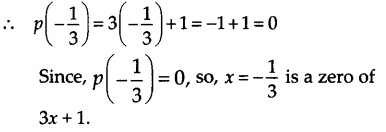
(ii) We have, p(x) = 5x – π
∴ p(−13)=3(−13)+1=−1+1=0
(iii) We have, p(x) = x2 – 1
∴ p(1) = (1)2 – 1 = 1 – 1=0
Since, p(1) = 0, so x = 1 is a zero of x2 -1.
Also, p(-1) = (-1)2 -1 = 1 – 1 = 0
Since p(-1) = 0, so, x = -1, is also a zero of x2 – 1.
(iv) We have, p(x) = (x + 1)(x – 2)
∴ p(-1) = (-1 +1) (-1 – 2) = (0)(- 3) = 0
Since, p(-1) = 0, so, x = -1 is a zero of (x + 1)(x – 2).
Also, p( 2) = (2 + 1)(2 – 2) = (3)(0) = 0
Since, p(2) = 0, so, x = 2 is also a zero of (x + 1)(x – 2).
(v) We have, p(x) = x2
∴ p(o) = (0)2 = 0
Since, p(0) = 0, so, x = 0 is a zero of x2.
(vi) We have, p(x) = lx + m
(vii) We have, p(x) = 3x2 – 1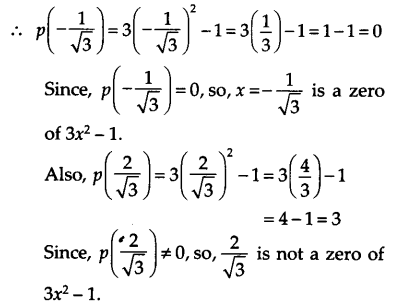
(viii) We have, p(x) = 2x + 1
∴ p(12)=2(12)+1=1+1=2
Since, p(12) ≠ 0, so, x = 12 is not a zero of 2x + 1.
Question 4.
Find the zero of the polynomial in each of the following cases
(i) p(x)=x+5
(ii) p (x) = x – 5
(iii) p (x) = 2x + 5
(iv) p (x) = 3x – 2
(v) p (x) = 3x
(vi) p (x)= ax, a≠0
(vii) p (x) = cx + d, c ≠ 0 where c and d are real numbers.
Solution:
(i) We have, p(x) = x + 5. Since, p(x) = 0
⇒ x + 5 = 0
⇒ x = -5.
Thus, zero of x + 5 is -5.
(ii) We have, p(x) = x – 5.
Since, p(x) = 0 ⇒ x – 5 = 0 ⇒ x = -5
Thus, zero of x – 5 is 5.
(iii) We have, p(x) = 2x + 5. Since, p(x) = 0
⇒ 2x + 5 =0
⇒ 2x = -5
⇒ x = −52
Thus, zero of 2x + 5 is −52 .
(iv) We have, p(x) = 3x – 2. Since, p(x) = 0
⇒ 3x – 2 = 0
⇒ 3x = 2
⇒ x = 23
Thus, zero of 3x – 2 is 23
(v) We have, p(x) = 3x. Since, p(x) = 0
⇒ 3x = 0 ⇒ x = 0
Thus, zero of 3x is 0.
(vi) We have, p(x) = ax, a ≠ 0.
Since, p(x) = 0 => ax = 0 => x-0
Thus, zero of ax is 0.
(vii) We have, p(x) = cx + d. Since, p(x) = 0
⇒ cx + d = 0 ⇒ cx = -d ⇒ x=−dc
Thus, zero of cx + d is −dc
Class 9 Math Ch 2 Polynomials Ex 2.3
Question 1.
Find the remainder when x3 + 3x2 + 3x + 1 is divided by
(i) x + 1
(ii) x – 12
(iii) x
(iv) x + π
(v) 5 + 2x
Solution:
Let p(x) = x3 + 3x2 + 3x +1
(i) The zero of x + 1 is -1.
∴ p(-1) = (-1)3 + 3(-1)2 + 3(-1) +1
= -1 + 3- 3 + 1 = 0
Thus, the required remainder = 0
(ii) The zero of x−12 is 12
Thus, the required remainder = 278
(iii) The zero of x is 0.
∴ p(0) = (0)3 + 3(0)2 + 3(0) + 1
= 0 + 0 + 0 + 1 = 1
Thus, the required remainder = 1.
(iv) The zero of x + π is -π.
p(-π) = (-π)3 + 3(- π)22 + 3(- π) +1
= -π3 + 3π2 + (-3π) + 1
= – π3 + 3π2 – 3π +1
Thus, the required remainder is -π3 + 3π2 – 3π+1.
(v) The zero of 5 + 2x is −52 .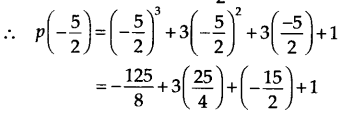

Thus, the required remainder is −278 .
Question 2.
Find the remainder when x3 – ax2 + 6x – a is divided by x – a.
Solution:
We have, p(x) = x3 – ax2 + 6x – a and zero of x – a is a.
∴ p(a) = (a)3 – a(a)2 + 6(a) – a
= a3 – a3 + 6a – a = 5a
Thus, the required remainder is 5a.
Question 3.
Check whether 7 + 3x is a factor of 3x3+7x.
Solution:
We have, p(x) = 3x3+7x. and zero of 7 + 3x is −73.
Since,( −4909) ≠ 0
i.e. the remainder is not 0.
∴ 3x3 + 7x is not divisib1e by 7 + 3x.
Thus, 7 + 3x is not a factor of 3x3 + 7x.
Class 9 Math Ch 2 Polynomials Ex 2.4
Question 1.
Determine which of the following polynomials has (x +1) a factor.
(i) x3+x2+x +1
(ii) x4 + x3 + x2 + x + 1
(iii) x4 + 3x3 + 3x2 + x + 1
(iv) x3 – x2 – (2 +√2 )x + √2
Solution:
The zero of x + 1 is -1.
(i) Let p (x) = x3 + x2 + x + 1
∴ p (-1) = (-1)3 + (-1)2 + (-1) + 1 .
= -1 + 1 – 1 + 1
⇒ p (- 1) = 0
So, (x+ 1) is a factor of x3 + x2 + x + 1.
(ii) Let p (x) = x4 + x3 + x2 + x + 1
∴ P(-1) = (-1)4 + (-1)3 + (-1)2 + (-1)+1
= 1 – 1 + 1 – 1 + 1
⇒ P (-1) ≠ 1
So, (x + 1) is not a factor of x4 + x3 + x2 + x+ 1.
(iii) Let p (x) = x4 + 3x3 + 3x2 + x + 1 .
∴ p (-1)= (-1)4 + 3 (-1)3 + 3 (-1)2 + (- 1) + 1
= 1 – 3 + 3 – 1 + 1 = 1
⇒ p (-1) ≠ 0
So, (x + 1) is not a factor of x4 + 3x3 + 3x2 + x+ 1.
(iv) Let p (x) = x3 – x2 – (2 + √2) x + √2
∴ p (- 1) =(- 1)3- (-1)2 – (2 + √2)(-1) + √2
= -1 – 1 + 2 + √2 + √2
= 2√2
⇒ p (-1) ≠ 0
So, (x + 1) is not a factor of x3 – x2 – (2 + √2) x + √2.
Question 2.
Use the Factor Theorem to determine whether g (x) is a factor of p (x) in each of the following cases
(i) p (x)= 2x3 + x2 – 2x – 1, g (x) = x + 1
(ii) p(x)= x3 + 3x2 + 3x + 1, g (x) = x + 2
(iii) p (x) = x3 – 4x2 + x + 6, g (x) = x – 3
Solution:
(i) We have, p (x)= 2x3 + x2 – 2x – 1 and g (x) = x + 1
∴ p(-1) = 2(-1)3 + (-1)2 – 2(-1) – 1
= 2(-1) + 1 + 2 – 1
= -2 + 1 + 2 -1 = 0
⇒ p(-1) = 0, so g(x) is a factor of p(x).
(ii) We have, p(x) x3 + 3x2 + 3x + 1 and g(x) = x + 2
∴ p(-2) = (-2)3 + 3(-2)2+ 3(-2) + 1
= -8 + 12 – 6 + 1
= -14 + 13
= -1
⇒ p(-2) ≠ 0, so g(x) is not a factor of p(x).
(iii) We have, = x3 – 4x2 + x + 6 and g (x) = x – 3
∴ p(3) = (3)3 – 4(3)2 + 3 + 6
= 27 – 4(9) + 3 + 6
= 27 – 36 + 3 + 6 = 0
⇒ p(3) = 0, so g(x) is a factor of p(x).
Question 3.
Find the value of k, if x – 1 is a factor of p (x) in each of the following cases
(i) p (x) = x2 + x + k
(ii) p (x) = 2x2 + kx + √2
(iii) p (x) = kx2 – √2 x + 1
(iv) p (x) = kx2 – 3x + k
Solution:
For (x – 1) to be a factor of p(x), p(1) should be equal to 0.
(i) Here, p(x) = x2 + x + k
Since, p(1) = (1)2 +1 + k
⇒ p(1) = k + 2 = 0
⇒ k = -2.
(ii) Here, p (x) = 2x2 + kx + √2
Since, p(1) = 2(1)2 + k(1) + √2
= 2 + k + √2 =0
k = -2 – √2 = -(2 + √2)
(iii) Here, p (x) = kx2 – √2 x + 1
Since, p(1) = k(1)2 – (1) + 1
= k – √2 + 1 = 0
⇒ k = √2 -1
(iv) Here, p(x) = kx2 – 3x + k
p(1) = k(1)2 – 3(1) + k
= k – 3 + k
= 2k – 3 = 0
⇒ k = 34
Question 4.
Factorise
(i) 12x2 – 7x +1
(ii) 2x2 + 7x + 3
(iii) 6x2 + 5x – 6
(iv) 3x2 – x – 4
Solution:
(i) We have,
12x2 – 7x + 1 = 12x2 – 4x- 3x + 1
= 4x (3x – 1 ) -1 (3x – 1)
= (3x -1) (4x -1)
Thus, 12x2 -7x + 3 = (2x – 1) (x + 3)
(ii) We have, 2x2 + 7x + 3 = 2x2 + x + 6x + 3
= x(2x + 1) + 3(2x + 1)
= (2x + 1)(x + 3)
Thus, 2×2 + 7x + 3 = (2x + 1)(x + 3)
(iii) We have, 6x2 + 5x – 6 = 6x2 + 9x – 4x – 6
= 3x(2x + 3) – 2(2x + 3)
= (2x + 3)(3x – 2)
Thus, 6x2 + 5x – 6 = (2x + 3)(3x – 2)
(iv) We have, 3x2 – x – 4 = 3x2 – 4x + 3x – 4
= x(3x – 4) + 1(3x – 4) = (3x – 4)(x + 1)
Thus, 3x2 – x – 4 = (3x – 4)(x + 1)
Question 5.
Factorise
(i) x3 – 2x2 – x + 2
(ii) x3 – 3x2 – 9x – 5
(iii) x3 + 13x2 + 32x + 20
(iv) 2y3 + y2 – 2y – 1
Solution:
(i) We have, x3 – 2x2 – x + 2
Rearranging the terms, we have x3 – x – 2x2 + 2
= x(x2 – 1) – 2(x2 -1) = (x2 – 1)(x – 2)
= [(x)2 – (1)2](x – 2)
= (x – 1)(x + 1)(x – 2)
[∵ (a2 – b2) = (a + b)(a-b)]
Thus, x3 – 2x2 – x + 2 = (x – 1)(x + 1)(x – 2)
(ii) We have, x3 – 3x2 – 9x – 5
= x3 + x2 – 4x2 – 4x – 5x – 5 ,
= x2 (x + 1) – 4x(x + 1) – 5(x + 1)
= (x + 1)(x2 – 4x – 5)
= (x + 1)(x2 – 5x + x – 5)
= (x + 1)[x(x – 5) + 1(x – 5)]
= (x + 1)(x – 5)(x + 1)
Thus, x3 – 3x2 – 9x – 5 = (x + 1)(x – 5)(x +1)
(iii) We have, x3 + 13x2 + 32x + 20
= x3 + x2 + 12x2 + 12x + 20x + 20
= x2(x + 1) + 12x(x +1) + 20(x + 1)
= (x + 1)(x2 + 12x + 20)
= (x + 1)(x2 + 2x + 10x + 20)
= (x + 1)[x(x + 2) + 10(x + 2)]
= (x + 1)(x + 2)(x + 10)
Thus, x3 + 13x2 + 32x + 20
= (x + 1)(x + 2)(x + 10)
(iv) We have, 2y3 + y2 – 2y – 1
= 2y3 – 2y2 + 3y2 – 3y + y – 1
= 2y2(y – 1) + 3y(y – 1) + 1(y – 1)
= (y – 1)(2y2 + 3y + 1)
= (y – 1)(2y2 + 2y + y + 1)
= (y – 1)[2y(y + 1) + 1(y + 1)]
= (y – 1)(y + 1)(2y + 1)
Thus, 2y3 + y2 – 2y – 1
= (y – 1)(y + 1)(2y +1)
Class 9 Math Ch 2 Polynomials Ex 2.5
Question 1.
Use suitable identities to find the following products
(i) (x + 4)(x + 10)
(ii) (x+8) (x -10)
(iii) (3x + 4) (3x – 5)
(iv) (y2+ 32) (y2– 32)
(v) (3 – 2x) (3 + 2x)
Solution:
(i) We have, (x+ 4) (x + 10)
Using identity,
(x+ a) (x+ b) = x2 + (a + b) x+ ab.
We have, (x + 4) (x + 10) = x2+(4 + 10) x + (4 x 10)
= x2 + 14x+40
(ii) We have, (x+ 8) (x -10)
Using identity,
(x + a) (x + b) = x2 + (a + b) x + ab
We have, (x + 8) (x – 10) = x2 + [8 + (-10)] x + (8) (- 10)
= x2 – 2x – 80
(iii) We have, (3x + 4) (3x – 5)
Using identity,
(x + a) (x + b) = x2 + (a + b) x + ab
We have, (3x + 4) (3x – 5) = (3x)2 + (4 – 5) x + (4) (- 5)
= 9x2 – x – 20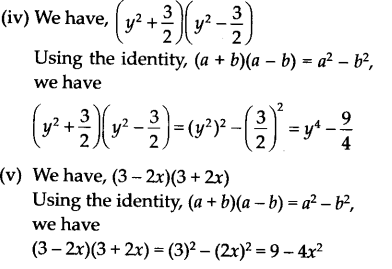
Question 2.
Evaluate the following products without multiplying directly
(i) 103 x 107
(ii) 95 x 96
(iii) 104 x 96
Solution:
(i)We have, 103 x 107 = (100 + 3) (100 + 7)
= ( 100)2 + (3 + 7) (100)+ (3 x 7)
[Using (x + a)(x + b) = x2 + (a + b)x + ab]
= 10000 + (10) x 100 + 21
= 10000 + 1000 + 21=11021
(ii) We have, 95 x 96 = (100 – 5) (100 – 4)
= ( 100)2 + [(- 5) + (- 4)] 100 + (- 5 x – 4)
[Using (x + a)(x + b) = x2 + (a + b)x + ab]
= 10000 + (-9) + 20 = 9120
= 10000 + (-900) + 20 = 9120
(iii) We have 104 x 96 = (100 + 4) (100 – 4)
= (100)2-42
[Using (a + b)(a -b) = a2– b2]
= 10000 – 16 = 9984
Question 3.
Factorise the following using appropriate identities
(i) 9x2 + 6xy + y2
(ii) 4y2-4y + 1
(iii) x2 – y2100
Solution:
(i) We have, 9x2 + 6xy + y2
= (3x)2 + 2(3x)(y) + (y)2
= (3x + y)2
[Using a2 + 2ab + b2 = (a + b)2]
= (3x + y)(3x + y)
(ii) We have, 4y2 – 4y + 12
= (2y)2 + 2(2y)(1) + (1)2
= (2y -1)2
[Using a2 – 2ab + b2 = (a- b)2]
= (2y – 1)(2y – 1 )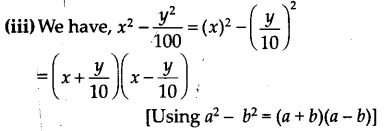
Question 4.
Expand each of the following, using suitable identity
(i) (x+2y+ 4z)2
(ii) (2x – y + z)2
(iii) (- 2x + 3y + 2z)2
(iv) (3a -7b – c)z
(v) (- 2x + 5y – 3z)2
(vi) [ 14a –14b + 1] 2
Solution:
We know that
(x + y + z)2 = x2 + y2 + z2 + 2xy + 2yz + 2zx
(i) (x + 2y + 4z)2
= x2 + (2y)2 + (4z)2 + 2 (x) (2y) + 2 (2y) (4z) + 2(4z) (x)
= x2 + 4y2 + 16z2 + 4xy + 16yz + 8 zx
(ii) (2x – y + z)2 = (2x)2 + (- y)2 + z2 + 2 (2x) (- y)+ 2 (- y) (z) + 2 (z) (2x)
= 4x2 + y2 + z2 – 4xy – 2yz + 4zx
(iii) (- 2x + 3y + 2z)2 = (- 2x)2 + (3y)2 + (2z)2 + 2 (- 2x) (3y)+ 2 (3y) (2z) + 2 (2z) (- 2x)
= 4x2 + 9y2 + 4z2 – 12xy + 12yz – 8zx
(iv) (3a -7b- c)2 = (3a)2 + (- 7b)2 + (- c)2 + 2 (3a) (- 7b) + 2 (- 7b) (- c) + 2 (- c) (3a)
= 9a2 + 49b2 + c2 – 42ab + 14bc – 6ac
(v)(- 2x + 5y- 3z)2 = (- 2x)2 + (5y)2 + (- 3z)2 + 2 (- 2x) (5y) + 2 (5y) (- 3z) + 2 (- 3z) (- 2x)
= 4x2 + 25y2 + 9z2 – 20xy – 30yz + 12zx
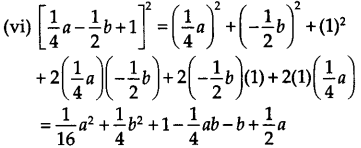
Question 5.
Factorise
(i) 4 x2 + 9y2 + 16z2 + 12xy – 24yz – 16xz
(ii) 2x2 + y2 + 8z2 – 2√2xy + 4√2yz – 8xz
Solution:
(i) 4x2 + 9y2 + 16z2 + 12xy – 24yz – 16xz
= (2x)2 + (3y)2 + (- 4z)2 + 2 (2x) (3y) + 2 (3y) (- 4z) + 2 (- 4z) (2x)
= (2x + 3y – 4z)2 = (2x + 3y + 4z) (2x + 3y – 4z)
(ii) 2x2 + y2 + 8z2 – 2√2xy + 4√2yz – 8xz
= (- √2x)2 + (y)2 + (2 √2z)2y + 2(- √2x) (y)+ 2 (y) (2√2z) + 2 (2√2z) (- √2x)
= (- √2x + y + 2 √2z)2
= (- √2x + y + 2 √2z) (- √2x + y + 2 √2z)
Question 6.
Write the following cubes in expanded form
Solution:
We have, (x + y)3 = x3 + y3 + 3xy(x + y) …(1)
and (x – y)3 = x3 – y3 – 3xy(x – y) …(2)
(i) (2x + 1)3 = (2x)3 + (1)3 + 3(2x)(1)(2x + 1) [By (1)]
= 8x3 + 1 + 6x(2x + 1)
= 8x3 + 12x2 + 6x + 1
(ii) (2a – 3b)3 = (2a)3 – (3b)3 – 3(2a)(3b)(2a – 3b) [By (2)]
= 8a3 – 27b3 – 18ab(2a – 3b)
= 8a3 – 27b3 – 36a2b + 54ab2

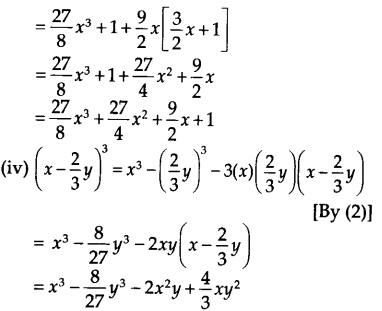
Question 7.
Evaluate the following using suitable identities
(i) (99)3
(ii) (102)3
(iii) (998)3
Solution:
(i) We have, 99 = (100 -1)
∴ 993 = (100 – 1)3
= (100)3 – 13 – 3(100)(1)(100 -1)
[Using (a – b)3 = a3 – b3 – 3ab (a – b)]
= 1000000 – 1 – 300(100 – 1)
= 1000000 -1 – 30000 + 300
= 1000300 – 30001 = 970299
(ii) We have, 102 =100 + 2
∴ 1023 = (100 + 2)3
= (100)3 + (2)3 + 3(100)(2)(100 + 2)
[Using (a + b)3 = a3 + b3 + 3ab (a + b)]
= 1000000 + 8 + 600(100 + 2)
= 1000000 + 8 + 60000 + 1200 = 1061208
(iii) We have, 998 = 1000 – 2
∴ (998)3 = (1000-2)3
= (1000)3– (2)3 – 3(1000)(2)(1000 – 2)
[Using (a – b)3 = a3 – b3 – 3ab (a – b)]
= 1000000000 – 8 – 6000(1000 – 2)
= 1000000000 – 8 – 6000000 +12000
= 994011992
Question 8.
Factorise each of the following
(i) 8a3 +b3 + 12a2b+6ab2
(ii) 8a3 -b3-12a2b+6ab2
(iii) 27-125a3 -135a+225a2
(iv) 64a3 -27b3 -144a2b + 108ab2![]()
Solution:
(i) 8a3 +b3 +12a2b+6ab2
= (2a)3 + (b)3 + 6ab(2a + b)
= (2a)3 + (b)3 + 3(2a)(b)(2a + b)
= (2 a + b)3
[Using a3 + b3 + 3 ab(a + b) = (a + b)3]
= (2a + b)(2a + b)(2a + b)
(ii) 8a3 – b3 – 12o2b + 6ab2
= (2a)3 – (b)3 – 3(2a)(b)(2a – b)
= (2a – b)3
[Using a3 + b3 + 3 ab(a + b) = (a + b)3]
= (2a – b) (2a – b) (2a – b)
(iii) 27 – 125a3 – 135a + 225a2
= (3)3 – (5a)3 – 3(3)(5a)(3 – 5a)
= (3 – 5a)3
[Using a3 + b3 + 3 ab(a + b) = (a + b)3]
= (3 – 5a) (3 – 5a) (3 – 5a)
(iv) 64a3 -27b3 -144a2b + 108ab2
= (4a)3 – (3b)3 – 3(4a)(3b)(4a – 3b)
= (4a – 3b)3
[Using a3 – b3 – 3 ab(a – b) = (a – b)3]
= (4a – 3b)(4a – 3b)(4a – 3b)
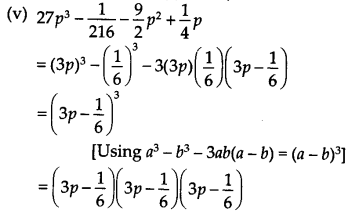
Question 9.
Verify
(i) x3 + y3 = (x + y)-(x2 – xy + y2)
(ii) x3 – y3 = (x – y) (x2 + xy + y2)
Solution:
(i) ∵ (x + y)3 = x3 + y3 + 3xy(x + y)
⇒ (x + y)3 – 3(x + y)(xy) = x3 + y3
⇒ (x + y)[(x + y)2-3xy] = x3 + y3
⇒ (x + y)(x2 + y2 – xy) = x3 + y3
Hence, verified.
(ii) ∵ (x – y)3 = x3 – y3 – 3xy(x – y)
⇒ (x – y)3 + 3xy(x – y) = x3 – y3
⇒ (x – y)[(x – y)2 + 3xy)] = x3 – y3
⇒ (x – y)(x2 + y2 + xy) = x3 – y3
Hence, verified.
Question 10.
Factorise each of the following
(i) 27y3 + 125z3
(ii) 64m3 – 343n3
[Hint See question 9]
Solution:
(i) We know that
x3 + y3 = (x + y)(x2 – xy + y2)
We have, 27y3 + 125z3 = (3y)3 + (5z)3
= (3y + 5z)[(3y)2 – (3y)(5z) + (5z)2]
= (3y + 5z)(9y2 – 15yz + 25z2)
(ii) We know that
x3 – y3 = (x – y)(x2 + xy + y2)
We have, 64m3 – 343n3 = (4m)3 – (7n)3
= (4m – 7n)[(4m)2 + (4m)(7n) + (7n)2]
= (4m – 7n)(16m2 + 28mn + 49n2)
Question 11.
Factorise 27x3 +y3 +z3 -9xyz.
Solution:
We have,
27x3 + y3 + z3 – 9xyz = (3x)3 + (y)3 + (z)3 – 3(3x)(y)(z)
Using the identity,
x3 + y3 + z3 – 3xyz = (x + y + z)(x2 + y2 + z2 – xy – yz – zx)
We have, (3x)3 + (y)3 + (z)3 – 3(3x)(y)(z)
= (3x + y + z)[(3x)3 + y3 + z3 – (3x × y) – (y × 2) – (z × 3x)]
= (3x + y + z)(9x2 + y2 + z2 – 3xy – yz – 3zx)
Question 12.
Verify that
x3 +y3 +z3 – 3xyz = 12 (x + y+z)[(x-y)2 + (y – z)2 +(z – x)2]
Solution:
R.H.S
= 12(x + y + z)[(x – y)2+(y – z)2+(z – x)2]
= 12 (x + y + 2)[(x2 + y2 – 2xy) + (y2 + z2 – 2yz) + (z2 + x2 – 2zx)]
= 12 (x + y + 2)(x2 + y2 + y2 + z2 + z2 + x2 – 2xy – 2yz – 2zx)
= 12 (x + y + z)[2(x2 + y2 + z2 – xy – yz – zx)]
= 2 x 12 x (x + y + z)(x2 + y2 + z2 – xy – yz – zx)
= (x + y + z)(x2 + y2 + z2 – xy – yz – zx)
= x3 + y3 + z3 – 3xyz = L.H.S.
Hence, verified.
Question 13.
If x + y + z = 0, show that x3 + y3 + z3 = 3 xyz.
Solution:
Since, x + y + z = 0
⇒ x + y = -z (x + y)3 = (-z)3
⇒ x3 + y3 + 3xy(x + y) = -z3
⇒ x3 + y3 + 3xy(-z) = -z3 [∵ x + y = -z]
⇒ x3 + y3 – 3xyz = -z3
⇒ x3 + y3 + z3 = 3xyz
Hence, if x + y + z = 0, then
x3 + y3 + z3 = 3xyz
Question 14.
Without actually calculating the cubes, find the value of each of the following
(i) (- 12)3 + (7)3 + (5)3
(ii) (28)3 + (- 15)3 + (- 13)3
Solution:
(i) We have, (-12)3 + (7)3 + (5)3
Let x = -12, y = 7 and z = 5.
Then, x + y + z = -12 + 7 + 5 = 0
We know that if x + y + z = 0, then, x3 + y3 + z3 = 3xyz
∴ (-12)3 + (7)3 + (5)3 = 3[(-12)(7)(5)]
= 3[-420] = -1260
(ii) We have, (28)3 + (-15)3 + (-13)3
Let x = 28, y = -15 and z = -13.
Then, x + y + z = 28 – 15 – 13 = 0
We know that if x + y + z = 0, then x3 + y3 + z3 = 3xyz
∴ (28)3 + (-15)3 + (-13)3 = 3(28)(-15)(-13)
= 3(5460) = 16380
Question 15.
Give possible expressions for the length and breadth of each of the following rectangles, in which their areas are given
(i) Area 25a2 – 35a + 12
(ii) Area 35y2 + 13y – 12
Solution:
Area of a rectangle = (Length) x (Breadth)
(i) 25a2 – 35a + 12 = 25a2 – 20a – 15a + 12 = 5a(5a – 4) – 3(5a – 4) = (5a – 4)(5a – 3)
Thus, the possible length and breadth are (5a – 3) and (5a – 4).
(ii) 35y2+ 13y -12 = 35y2 + 28y – 15y -12
= 7y(5y + 4) – 3(5y + 4) = (5 y + 4)(7y – 3)
Thus, the possible length and breadth are (7y – 3) and (5y + 4).
Question 16.
What are the possible expressions for the dimensions of the cuboids whose volumes are given below?
(i) Volume 3x2 – 12x
(ii) Volume 12ky2 + 8ky – 20k
Solution:
Volume of a cuboid = (Length) x (Breadth) x (Height)
(i) We have, 3x2 – 12x = 3(x2 – 4x)
= 3 x x x (x – 4)
∴ The possible dimensions of the cuboid are 3, x and (x – 4).
(ii) We have, 12ky2 + 8ky – 20k
= 4[3ky2 + 2ky – 5k] = 4[k(3y2 + 2y – 5)]
= 4 x k x (3y2 + 2y – 5)
= 4k[3y2 – 3y + 5y – 5]
= 4k[3y(y – 1) + 5(y – 1)]
= 4k[(3y + 5) x (y – 1)]
= 4k x (3y + 5) x (y – 1)
Thus, the possible dimensions of the cuboid are 4k, (3y + 5) and (y -1)
📘 Math & Science Solutions by Class
🔹 Class 10
🔹 Class 9
🔹 Class 8
🔹 Class 7
🔹 Class 6
🔹 Class 12
🔹 Class 11
- Class 11 Math Solutions
- Class 11 Physics Solutions
- Class 11 Chemistry Solutions
- Class 11 Biology Solutions
For the official Class 8 Science Solutions, you can visit:
- NCERT Textbooks (for Class 8):
